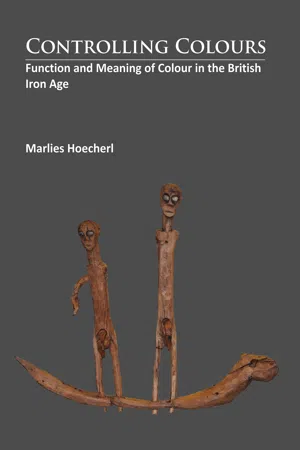
Controlling Colours
Function and meaning of Colour in the British Iron Age
- 154 pages
- English
- PDF
- Available on iOS & Android
About this book
Colour defines our material world, operates as a communication tool and creates meaning. But despite the wealth of colour present in British Iron Age archaeology, interpretative studies have concentrated mostly on the shape of material objects and their decoration, with at best fleeting references to colour. This book revisits well known and well documented sites or artefacts and explores their colours and colour connotations – whether hue or luminosity, whether natural or man-made, whether innate or deliberately applied - by looking at various contexts such as processes, landscape, iconography, body decoration or the colour connotations of death. The importance of changes in colour caused by passing of time, processing, handling or exposure, as well as the deliberate concealment or defacing of colour is looked at. Finally and most importantly, using methodologies ranging from examination of written sources, comparisons from the fields of anthropology and ethnology to experimental archaeology the author attempts to shed light on the symbolic meaning behind such colours or colour contexts and contribute to our understanding of Iron Age cosmologies.
Frequently asked questions
- Essential is ideal for learners and professionals who enjoy exploring a wide range of subjects. Access the Essential Library with 800,000+ trusted titles and best-sellers across business, personal growth, and the humanities. Includes unlimited reading time and Standard Read Aloud voice.
- Complete: Perfect for advanced learners and researchers needing full, unrestricted access. Unlock 1.4M+ books across hundreds of subjects, including academic and specialized titles. The Complete Plan also includes advanced features like Premium Read Aloud and Research Assistant.
Please note we cannot support devices running on iOS 13 and Android 7 or earlier. Learn more about using the app.
Information
Table of contents
- Cover
- Title Page
- Copyright Page
- Contents
- List of Figures
- Acknowledgements
- Chapter 1
- Chapter 2
- Chapter 3
- Chapter 4
- Chapter 5
- Chapter 6
- Chapter 7
- Figure 1: Decorated Terrets
- Figure 2: Decorated Metalware from North Britain as listed by MacGregor (1976)
- Chapter 8
- Chapter 9
- Figure 3: Body Part Associations
- Figure 4: Distribution of Mirror Burials in England and Wales
- Figure 5: Analysis of Colour and Colour Connotations in Mirror Burials
- Figure 6: Material of Mirrors
- Figure 10: Evidence of Containment of Mirrors
- Figure 8: Gender Connotations of Mirrors
- Chapter 10
- Chapter 11
- Figure 11a: Carl Andre, 32 Bar Square Fugue on 4 Ancient Metals –Munich Museum Brandhorst
- Figure 12a: Chalk Figurine with Hooded Cloak
- Figure 12c: Deal Kent Man
- Figure 12d: Battersea Head
- Figure 13a: Roos Carr Figurines
- Figure 13c: Ballachulish Woman
- Figure 13d: Kingsteignton Idol
- Figure 14b: Snettisham Gold Torques
- Figure 14c: Desborough Mirror
- Figure 14d: Monasterevin Disc
- Figure 15a: Iron Spear with Crosshatched Bronze Decoration from River Thames
- Figure 15b: Bronze Sword Scabbard with crosshatched Bronze Decoration from Bughtorpe, Yorkshire
- Figure 15d: Witham Shield
- Figure 16a: Battersea Shield
- Figure 16b: Strap Fitting from Westhall in Suffolk
- Figure 16c: Terret from Whitton
- Figure 16d: Harness Fittings including Harness Fitting from Polden Hill, Eared Mount from Westhall, Suffolk, Bridle Bit from Saham Toney
- Figure 17b: Saham Toney Terret
- Figure 17c: Kirkburn Sword
- Figure 17d: Part of Santon Eared Mount
- Figure 18a: Part of Santon Eared Mount Variation of Colour
- Figure 18d: Water coloured by Yew
- Figure 19a: Pieces of Yew Oak and Alder
- Figure 19b: Yew Oak and Alder immersed in Water
- Figure 19c: Yew Oak and Alder exposed to elements
- Figure 19d: Holcombe Mirror handle with red glass decoration
- Figure 20a: Drawing of Hispanic Vase Fragment Excarnation by Scavenger
- Figure 20c: Welwyn Garden burial gaming pieces
- Figure 20d: Lindow Man II